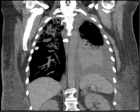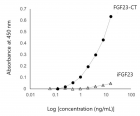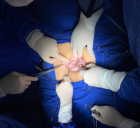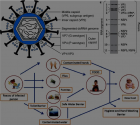Current Issue (Volume - 7 | Issue - 3)
Acute Inflammatory Reaction After Radiotherapy to Bilateral Orbital Metastasis from Melanoma
Published on: 15th September, 2023
Orbital melanoma is a subtype of periocular melanoma that can present from primary, secondary (arising from local invasion), or metastatic disease [1]. Melanoma metastasis to the orbit is rare with the majority of metastases occurring in subcutaneous tissue, nonregional lymph nodes, lungs, liver, brain, and bone [2]. Despite melanoma being relatively radioresistant, radiation therapy can be considered in an adjuvant or palliative setting [3]. In the palliative setting specifically, radiation therapy is highly effective in alleviating symptoms due to mass effect [3]. However, significant ocular and orbital complications may occur as a direct result of radiation therapy.
Multiparametric MRI for the Assessment of Treatment Effect and Tumor Recurrence in Soft-tissue Sarcoma of the Extremities
Published on: 20th September, 2023
Soft-tissue sarcomas are a rare and complex group of malignant tumors. Advanced MRI sequences such as diffusion-weighted imaging (DWI) and perfusion-weighted imaging/dynamic contrast enhancement (PWI/DCE) can provide valuable tumor characterization and treatment response assessment. In the case of archetypical cellular tumors such as Pleomorphic Undifferentiated sarcoma (UPS), Good responders often display right-side displacement of the ADC intensity histogram, resulting in increased ADC-mean and decreased kurtosis and Skewness compared with Baseline and poor responders’ more left-sided curve. The PWI/DCE pattern most often associated with a good response is the presence of a “capsular-like” enhancement and a TIC type 2. Sarcoma hemorrhage patterns on SWI emerge during treatment, including “interstitial,” globular,” “luminal,” and incomplete and complete “peripheral ring-like” tumor wall hemosiderin impregnation. Treatment-induced bleeding is typically associated with low SWI-mean values and a left-sided intensity histogram with positive Skewness.During post-surgical surveillance, DCE MR imaging can reliably distinguish recurrent sarcoma from post-surgical scarring. TICs III, IV, and V raise the suspicion of local tumor recurrence, while TIC type II usually represents benign post-operative change such as granulation tissue. Advanced MRI is an essential tool for assessing sarcomas during and after therapy.
Therapy of Walker Carcinosarcoma with Pectin and Cyclophosphane
Published on: 4th October, 2023
Scientific interest in low-molecular-weight pectins is not accidental. Despite the experimental material widely presented in the literature on the pharmacological effects of pectins, the clinical application of the developments has not yet been fully implemented. On the one hand, antitumor potential is registered in polymers with a mass of hundreds of kilodaltons, on the other hand, practically nothing is known about such in pectin derivatives weighing less than 20 kDa. In addition, the issues of assessing the nature of the pharmacological interaction of nanoscale pectin and conventional cytostatics are not covered. The aim of this work is an experimental study of the antitumor potential of low-molecular, low-esterified pectin in combination with a cytostatic agent on a model of Walker’s carcinosarcoma. Pectin therapy of Walker’s transplanted tumor in several series of experiments consistently caused inhibition of its growth from 60% to 80%. The combined use of pectin and cyclophosphane caused inhibition of tumor growth up to 72.4%. The increase in life expectancy in the “pectin + cyclophosphane” group versus the “cyclophosphane” group was 200%. It can be concluded that nanoscale pectin is a promising drug for in-depth study since it meets the criteria of primary screening (increase in animal life expectancy, inhibition of tumor growth, survival without tumor growth).
A Rare Coexistence: Breast Cancer, Pheochromocytoma and Von Recklinghausen Disease
Published on: 11th December, 2023
Breast cancer associated with type-1 neurofibromatosis is a rare clinical entity. These patients have a higher risk of developing various types of cancers, especially tumors derived from the embryogenic neural crest, such as pheochromocytoma. This publication aims to add to the literature a rare association between Type-1 Neurofibromatosis, breast cancer, and pheochromocytoma.We present a rare case of a 51-year-old Tunisian woman with neurofibromatosis who was diagnosed with breast cancer and pheochromocytoma. The breast tumor was classified as T4b N1M0, and the discovery of the pheochromocytoma was incidental to thoracic-abdominal-pelvic CT. She underwent surgery to remove the adrenal gland and was referred to medical oncologists to receive chemotherapy for her breast cancer. Type-1 Neurofibromatosis disorder is a benign disease but can expose patients to numerous neoplasms. The challenging diagnosis at an early stage can worsen the prognosis and make medical care more difficult.

HSPI: We're glad you're here. Please click "create a new Query" if you are a new visitor to our website and need further information from us.
If you are already a member of our network and need to keep track of any developments regarding a question you have already submitted, click "take me to my Query."


























































































































































